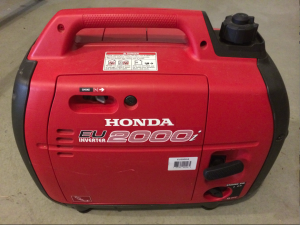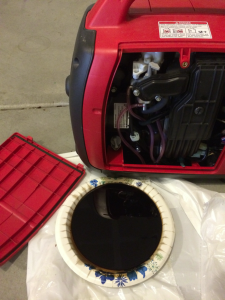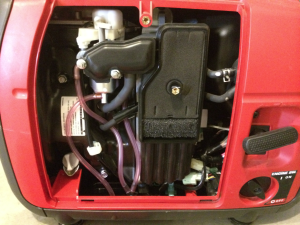
If you’re anything like me, you run your generator to death during the regular season without even thinking about performing regular maintenance. You may also be like me in that I’m a cold-weather bastard, not a warm-weather dick, so that I means I get a bit more down time during the winter months. So, what better time to make sure that your generator is fresh and ready to rock for the new season?
Each generator brand will advise you to perform maintenance at slightly different intervals and different ways, but in general, if you do these next few things at least once a year depending on how much you use it, you should be ok.

1. Engine Oil
First and foremost, you should check your oil at semi-regular intervals to make sure you’re topped off and good to go. My particular generator has a low-oil alert LED on it, but I check mine about once per month anyway and add a tiny bit just to make sure I stay close to the “full” line. I use standard 4-stroke 10W-30 oil, as it’s the best all-purpose oil for typical temperature ranges. That said, if you run generator at temperatures much below freezing, then you should consider using 5W-30.
Once per year, I also do a full oil change. This is actually pretty simple to do…It’s best to run the generator for a few minutes to warm the oil up a bit, as it flows out a lot easier than when it’s cold. This will ensure that you get ALL of the oil out of the engine.
I use a couple of paper plates on top of a plastic garbage bag to make sure that I don’t spill all over the garage. The generator is fairly lightweight and easy to manipulate, so if you fill a plate, then just tip it back to it’s feet and put a new plate under it to get the rest of the oil. Once the engine is empty, take your favorite oil and fill ‘er up! 🙂
2. Air Filter
Most people that I talk to completely forget about the air filtration system on their generator, but it’s something that you want to make sure to keep clean so that your generator continues to run at peak efficiency. Again, this is easy to do and may need to be done more or less often than once or twice a year depending on what environment you typically run in. If you run your generator in a dusty environment, then you should be checking this out much more often…I live in rainy Seattle, so my filter doesn’t take as much of a beating as other peoples’.
Nevertheless, gain access to your air filter and check it for debris, dust, dirt, or other contaminants. If the filter is any color other than the standard grayish or whitish foam, then you need to clean it. To do this, pull the filter(s) out of the generator and rinse them off first to get all the major chunks out. Then, soak them in some warm water and dish soap or use an air filter cleaning solvent, if you have that available. Once they’re clean, make sure to rinse them very well and then allow them to dry thoroughly. Foam can suck up a lot of moisture, so I like to let them sit out at room temperature at least overnight, if not for an entire day to make sure they’re bone-dry.
After they’re completely dry, soak them in the clean oil that you just used to do your oil change above. Wring them out really well to make sure that they’re not dripping or sopping wet with oil and then reinstall them. The oil on the filters will help trap dust and dirt particles when they’re ingested so that they don’t get further into your engine and cause damage.
3. Spark Plug
Like the air filter, the spark plug is another item that a lot of people forget about, but it can cause you a lot of trouble if it’s not in good condition. First, find where it’s located and remove it…what we’re looking for here is damage to the copper gasket that seals against the engine head, grime and crusty deposits in and around the spark gap and insulator, damage to the insulator itself, and the spark gap dimensions.
If the seal is damaged in anyway especially if there’s a radial crease or deep scratch in it, replace it. A bad seal is one of the quickest ways of damaging your engine, so don’t risk it. Also, if the insulator is damaged or cracked, replace the plug. Remove and grime or deposits from the plug with some alcohol and a brush and then check that the gap is between 0.5-0.75mm wide. If it’s not, carefully bend the electrode back into that range. Once you’re done, reinstall the plug and close up the generator. You’re done!
There are a few other things that can be done to service the generator, but they tend to be a bit more advanced and most brands will recommend that you take them to a service center to have them done. If you’re comfortable with doing these things, then by all means have at it, but if you’re like me…then you’re probably only going to do these three regularly.
Remember, if your generator doesn’t work, then your big electrics are grounded, so don’t neglect this important and powerful tool in your heli arsenal… 😉
– Justin


